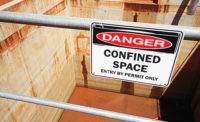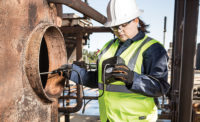Some of these myths include:
1 Daily bump tests and calibration are not necessary.
FALSE. Gas detection systems must be bump tested and calibrated prior to each use, even if the device conducts a self-bump test. Not performing these two tests could mean the difference between life and death.
When a device conducts a self-bump test, it is to ensure it is operational. It does not verify that the instrument will be able to detect harmful gas levels, which is why it is absolutely necessary that a manual bump test be performed. If any type of residue, dirt, oil, etc., penetrates the device and inadvertently adheres to the membrane, the self-bump test will incorrectly provide a green light for use even though the gas monitor will be unable to detect toxic levels of gas. The bump test also checks the calibration of the sensor. This ensures that the alarms work and are set correctly.
Calibration confirms that gas detectors will provide results that meet or exceed defined criteria. Calibration also assists with determining the condition of the gas detector’s sensor, which is extremely important as sensors possess a limited lifespan.
2 Data produced by gas monitors should only be reviewed following an incident.
FALSE. As devices have evolved, so too have their data-logging capabilities, making insight gleaned from regular review of their data absolutely invaluable. In addition to offering insights to achieving a safer and more productive work environment, regular review of data from gas detection technology:
x Provides insurance companies with more assurances of calibrated equipment throughout the year, helping to reduce the cost of liability insurance;
x Eliminates the cost of human error in the maintenance of gas detection systems as data can inform on-alert users when the operability of the system’s hardware or software is compromised;
x Identifies gaps in safety programs that need to be corrected; and
x Enhances management of the instrumentation fleet through the use of predictive maintenance contributing to greater internal efficiencies and minimizing cost of equipment repairs.
3 Ongoing training on gas detection technology is overkill.
FALSE. There is no such thing as too much training. A gas detection system is only as effective as those who use it. Training should occur in the following areas to maximize the potential of gas detection systems:
x Hazardous gases present onsite;
x Limitations of gas detection equipment and sensor technology;
x Calibration and maintenance; and
x Hands-on operation and instrument review.
Results of a recent survey reinforce the importance of regular training and education. “The 1ppm (parts per million) Hydrogen Sulfide Threshold: Are you prepared?”, completed by Dräger with the American Society of Safety Engineers (ASSE), polled ASSE members to determine their awareness of the new ACGIH hydrogen sulfide TLV recommending lower thresholds for detection of hazardous gases and the preparedness of their organizations to meet this threshold. The study revealed 53 percent of safety experts in the oil and gas industry are unaware of the new threshold standards.
4 There is really no big difference between using a gas detector with a t-90 time of 15 seconds versus 25-40 seconds.
FALSE. There is a life and death difference. While the disparity between five to ten seconds may seem minimal, those few seconds can determine whether or not a worker walks away from a lethal gas event, especially one involving H2S.
When H2S gas is simultaneously introduced to these two monitors, neither will immediately react. After a few seconds, the instrument with a t-90 time of 15 seconds will begin to register a gas amount. The device that has a t-90 time of 25-40 seconds will show no digital readout.
The numbers on the device with the t-90 time of 15 seconds will however continue to climb until they read 10 ppm. At this point the other device with the longer t-90 time will have yet to register a reading even though it will have been exposed to the same amount of gas. The worker wearing this device will start to suffer from a decreased level of oxygen in the blood and decreased level of muscle activity. This worker will experience this for 10 seconds without the alarm sounding to warn of the dangerous H2S level.
As gas concentrations increase, both monitors will continue to respond to the gas. After a minute and 35 seconds of gas exposure, the device with the 15 second t-90 time will measure 15 ppm and go into an A2 alarm. The worker wearing this monitor will be notified of the dangerous conditions and can evacuate the area. Even though the monitor with the longer t-90 time will have been exposed to the same level of gas for the same amount of time, it will take another 42 seconds before it goes into full A2 alarm to alert the user of the presence of 15 ppm of H2S.
During these 42 seconds of 15 ppm exposure, the worker will be subject to eye irritation, headache, dizziness, nausea, throat and eye irritation, coughing and breathing difficulty.
Additionally, by the end of these 42 seconds, the actual level of exposure will have risen to nearly 20 ppm. At this level of exposure, all of the previous symptoms will continue to worsen and memory loss may occur.
It is essential that companies equip their crews with solutions that will signal them to harm before it is too late.
5 All gas detectors are created equal.
FALSE. While all gas detectors are developed to meet the same baseline standards, differences exist between models.
While many detectors on the market feature sensors from suppliers, others feature their own. Companies possessing a long history in serving the oil and gas industry tend to design and use their own sensors as they have the insight and capacity needed to produce best-in-class sensors for their detectors.
Other telling signs of a quality detector are response time, warranty, design that will withstand harsh environments, and total cost of ownership. While a detector at a higher price point may initially seem restrictive, a higher-quality product will last longer and be less susceptible to breakdowns providing the return on investment.
The above statements are made based on information and facts obtained by Draeger. Draeger disclaims all liability arising from reliance on same.


